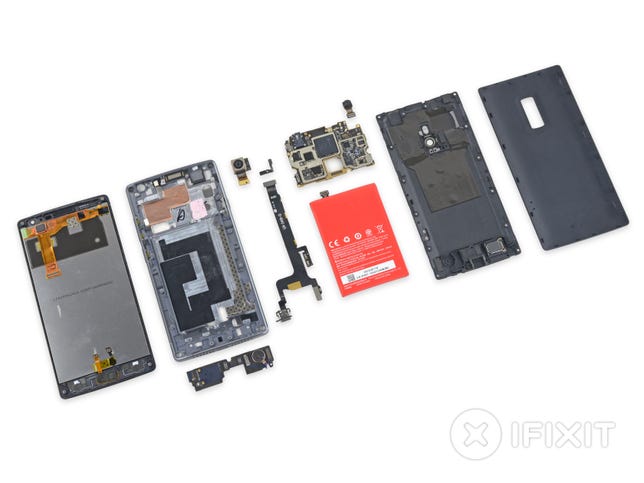
OnePlus, the China-based handset maker that has made a name for itself by offering high-end devices, has another reason for Android enthusiasts to celebrate: its latest smartphone is awfully easy to fix.
The OnePlus 2 Android-based smartphone earned a repairability score of 7 out of 10 from iFixit, a company that tears down electronics and sells tools to help users fix their own products. The score, which equals the repairability rating on Apple’s iPhone 6 Plus, was boosted for the handset’s use of modular components that can be replaced independently without worry of buying a whole new smartphone. The OnePlus 2 easily bested its predecessor, the OnePlus One, which could only muster a 5 out of 10 in iFixit’s review of that device.
While iFixit’s teardowns mean little to the average consumer who has no interest in breaking open a device to fix internal components, there is a subset of enthusiasts who often take apart devices to fix everything from screens to bad batteries to internal components. It’s that group that iFixit caters to, and it’s one — especially in the Android space — that is larger than one may think.
The OnePlus 2 is arguably doing the most of any smartphone on the market to excite Android enthusiasts. The device, which OnePlus calls the “2016 flagship killer,” comes with high-end specs, including a 5.5-inch screen, a 13-megapixel rear-facing camera, and a USB-C port, making it one of the first mass-market smartphones on the market to come with that port. It’s also running a modified version of Android developed in-house by OnePlus called Oxygen. The smartphone starts at $329.
OnePlus came on the scene with a splash last year when it unveiled its OnePlus One. The company had initially offered an invite-only method for buying its devices to control its costs and build a viral component to its marketing. The technique paid off, and has since made OnePlus a noted handset maker in the Android space. In 2013, when the company was founded, it had just 10 employees. It now has 900 employees and growing fast.
OnePlus has followed a similar strategy with the OnePlus Two by offering its device on an invite-only basis. The company, which faced issues getting invites to customers due to high demand for its OnePlus One, said things would be better this time around. On August 13, however, OnePlus announced that it will be rolling out invites more slowly than initially planned. The company blamed the slow rollout on issues it’s seeing in the manufacturing process, as well as some trouble it’s facing on software.
“There is continuous work being done on OxygenOS to improve the overall product experience,” the company wrote on its forums. “In addition, we’ve seen a few cases where the material of the new USB Type-C cable is not holding up to our standards. This is being resolved upstream. For these reasons, we will be rolling out invites slowly to closely monitor and act on user feedback.”
The announcement came after OnePlus announced on August 10 that it will delay its North America launch and start shipping to the continent two to three weeks after the handset is offered in Europe. The device went on sale to invite holders on August 11.
When customers get their OnePlus Two, they’ll find a handset bundled with Qualcomm components. According to iFixit, Qualcomm not only powers the processor in the OnePlus 2, but also the built-in audio chip, the component that manages dual-SIM connectivity, and its Wi-Fi chip. OnePlus is relying on Samsung for its memory and storage. Like the OnePlus One, iFixit discovered that the 2 also features the company’s signature red battery — a design touch only those breaking open the device will see.
Still, it wasn’t all nice inside the OnePlus 2: iFixit discovered that the device’s LCD screen and the glass digitizer, which converts user touch inputs to digital commands that control the operating system, are fused together. If the glass cracks, therefore, the digitizer must also be replaced, boosting cost.
OnePlus did not immediately respond to a request for comment.



